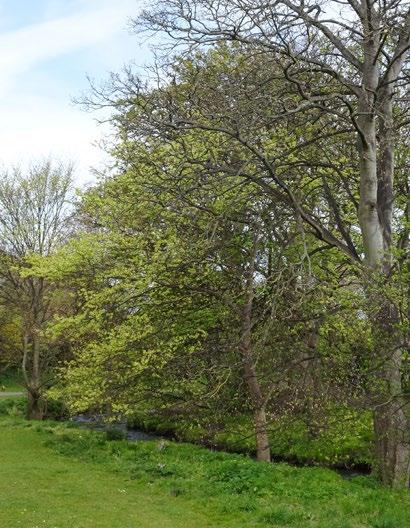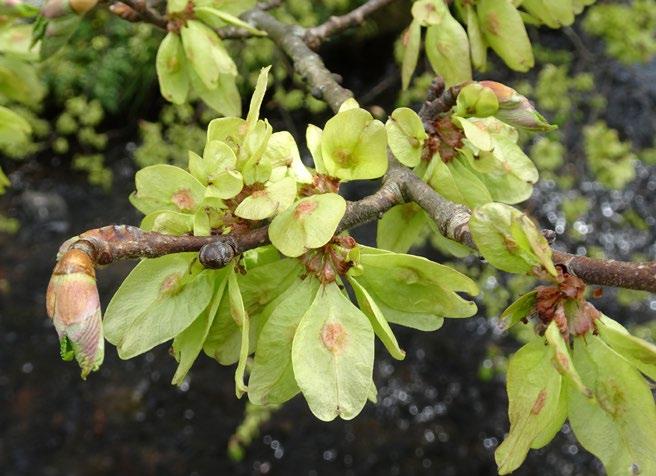
3 minute read
Max Coleman
Elm recording – a window of opportunity
MAX COLEMAN
Advertisement
A Wych Elm (Ulmus glabra) tree in fruit in April (with a leafless Sycamore (Acer pseudoplatanus) on right of image. Max Coleman
On 20 April, despite the national lockdown, I had a legitimate reason to travel between London and Edinburgh and I took the opportunity to spot elms from the train window as I went.
This was not just idle high-speed botany as I had a purpose in mind. I have always been sceptical of the Wych Elm (Ulmus glabra) distribution map in the Atlas as it shows almost blanket coverage with a few gaps in the Scottish Highlands. It is not the gaps in the north that bother me. Rather, it is the absence of gaps in the south. In my experience Wych Elm is quite uncommon in many parts of southern Britain. There are, however, some notable exceptions on calcareous rocks; for example, the Yorkshire Dales.
Anyway, as I was travelling at a time when all elms are easily spotted by their fruit clusters, I thought I would make a continuous observation to see if any patterns emerged. It is worth saying that elm fruits turn the trees green by their abundance, making them stand out against the other tree species that are still leafless. This time is a narrow window of opportunity for elm recording.
The rail journey approximates to a north/south transect and this is useful as Wych Elm is said to be more common in the north. The published hectad map by itself would give you the opposite impression.
South of Newcastle I could see few elms in the trackside land or the discernible distance. Field Elm (U. minor) and hybrids (U. minor × U. glabra) are the taxa you would expect to find in the south. Field elms are not known to be good colonists via seed and the very widespread English Elm clone (U. minor ‘Atinia’, formerly U. procera) is known to be sterile. Nevertheless, some elms are present, and these tend to be of quite narrow habit, even as young trees. Although I cannot be certain at over 100 mph, I suspect these southern elms are Field Elms.
In contrast, north of Newcastle elms become quite common and even abundant in suitable areas as you continue north. These elms look different to the southern elms as they are broad spreading from an early age. Coppicing of trackside trees is standard practice, and this does tend to encourage multiple stems and a broad habit. However, all trackside elms get the same treatment and the elms north of Newcastle do seem to have a broader habit of growth. Again, I cannot be certain, but my suspicion
is that these northern elms are Wych Elm. Wych Elm produces abundant seed that easily disperses on the wind and could colonise railway land in suitable areas. This is what appears to be happening.
What do I conclude? This evidence does point to Wych Elm being a species with a distinct northern bias; something which is not communicated by the records. I think southern records could easily be misidentifications of sucker regrowth from Field Elms and hybrids. Suckers have larger, hairy leaves typical of the juvenile growth form in most elms. They also have short petioles. All these characters point to Wych Elm. I, for one, would not blame anyone unfamiliar with elms if they made this simple mistake.
In summary, I would put a health warning on southern Wych Elm records as there is a chance that many of these records are misidentifications. Another factor to consider is the extent to which hectad mapping obscures patterns of regional variation. However, elms do have a real reputation for being hard to identify for the beginner. Hybridisation, past selection and planting of clones and adult/ juvenile leaf variation all contribute to this, although such problems are largely restricted to the south where both elm diversity and the history of human influence is greatest.
Max Coleman
BSBI Elm referee Royal Botanic Garden Edinburgh, 20A Inverleith Row, Edinburgh EH3 5LR
mcoleman@rbge.ac.uk

Wych Elm (Ulmus glabra) fruits. This image shows that the seed is well away from the apical notch in the samara (wing). Typically, it is positioned in the centre of the samara or even slightly closer to the base than the apex. In Field Elms and hybrids, the seed is displaced towards the apex and is often in contact with the apical notch. Max Coleman










